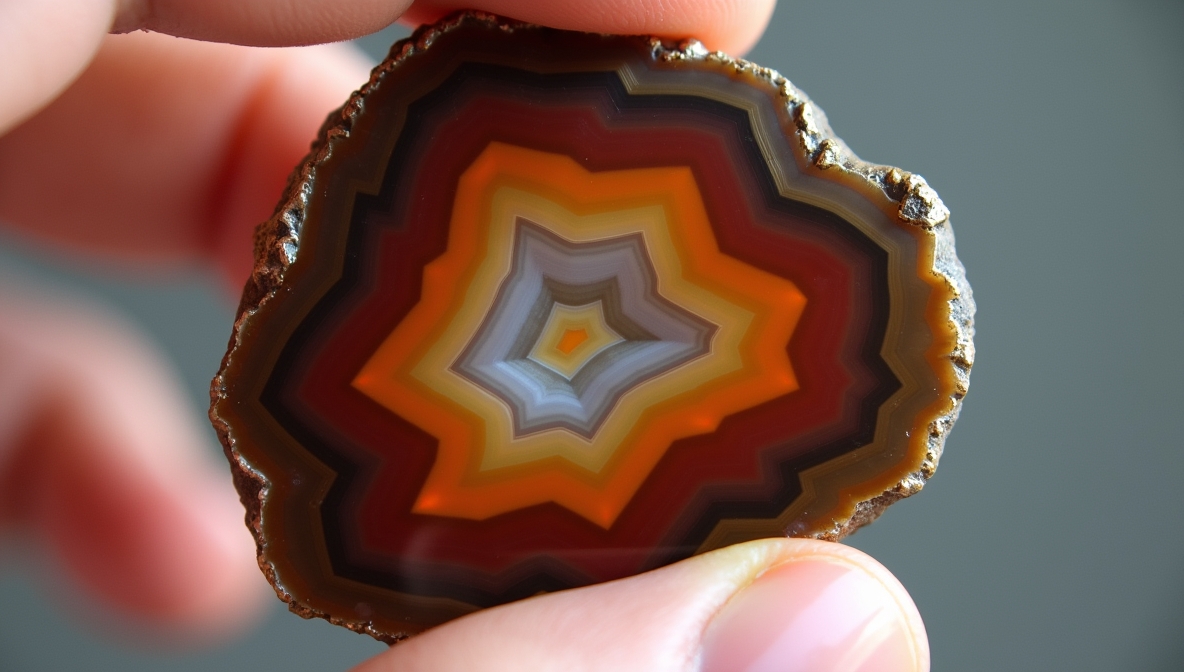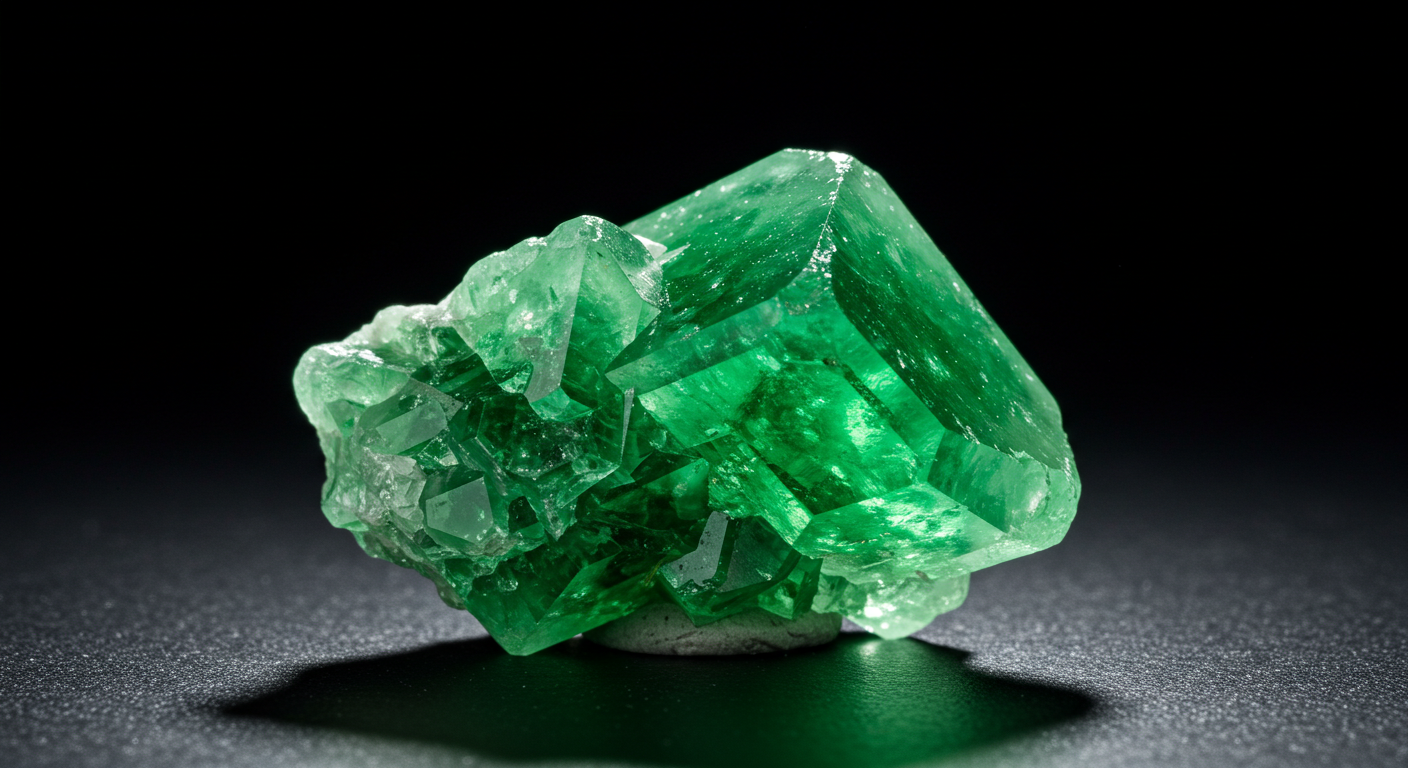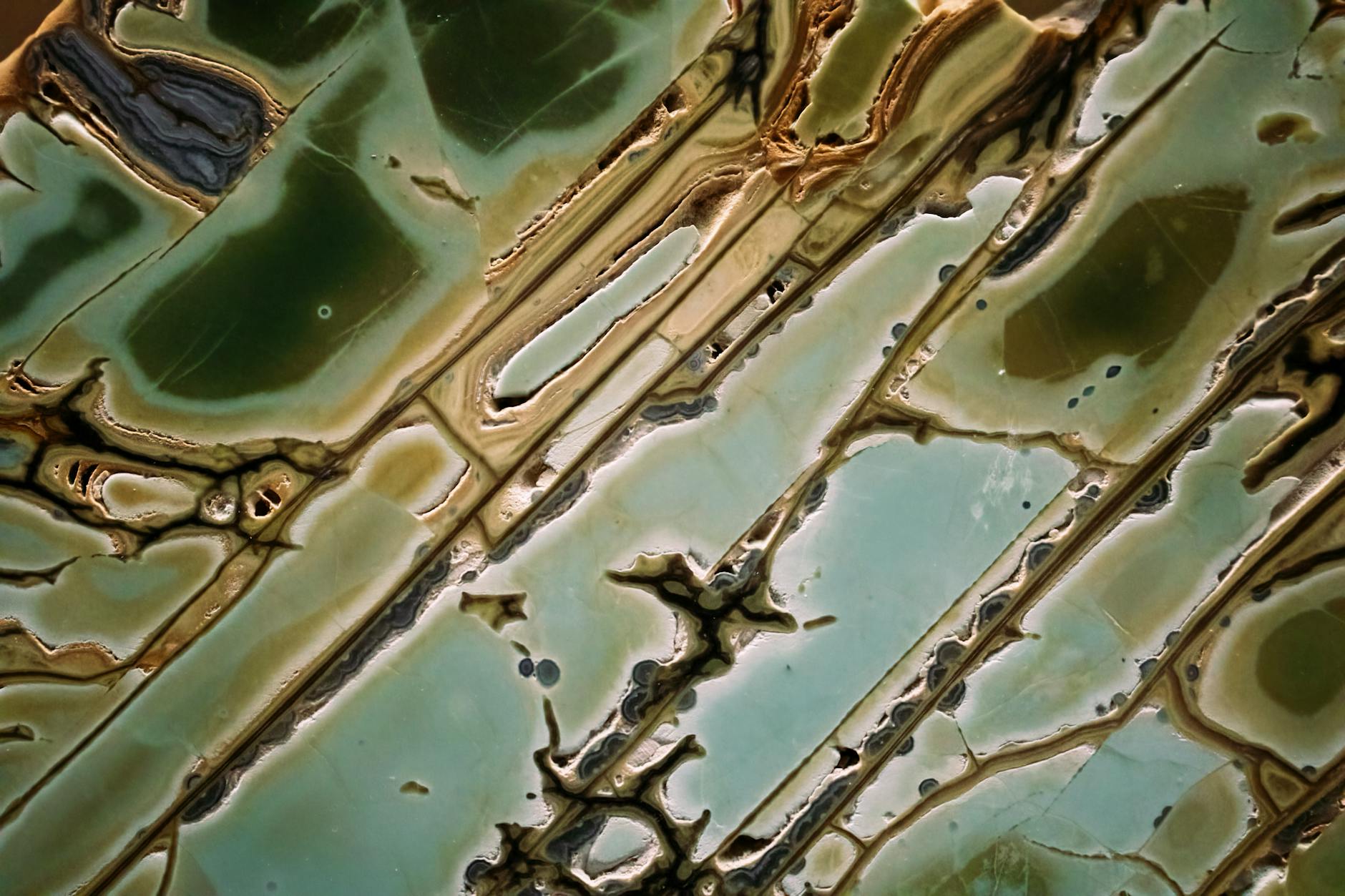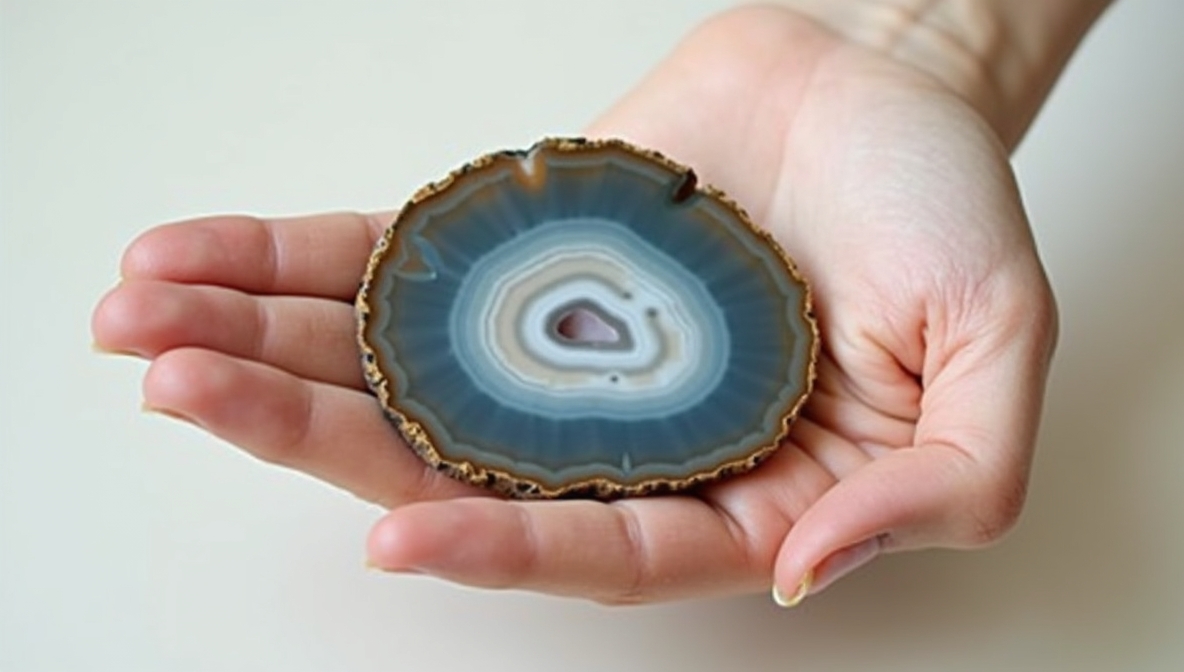See this incredible Macro Photo of a Polished Fortification Agate, Presented by Hand. Explore its intricate patterns and natural beauty.
Introduction:
Step into the mesmerizing micro-world of minerals with this striking close-up photograph. It captures a moment of human connection with a natural wonder: a hand presenting a polished, irregularly shaped agate specimen. This image is a celebration of intricate detail, showcasing the breathtaking patterns forged deep within the Earth. The macro photo perspective allows for an unparalleled view of the intricate and sharp, angular fortification banding that defines this particular agate, rendered in alternating layers of deep reddish-brown, orange-brown, near-black, and crisp white. A truly unique feature, a prominent nested diamond or rhombus pattern, is clearly visible in the lower half. The glossy surface reflects light, highlighting the complexity of the geological formation against a blurred background, ensuring all focus remains on the captivating stone.
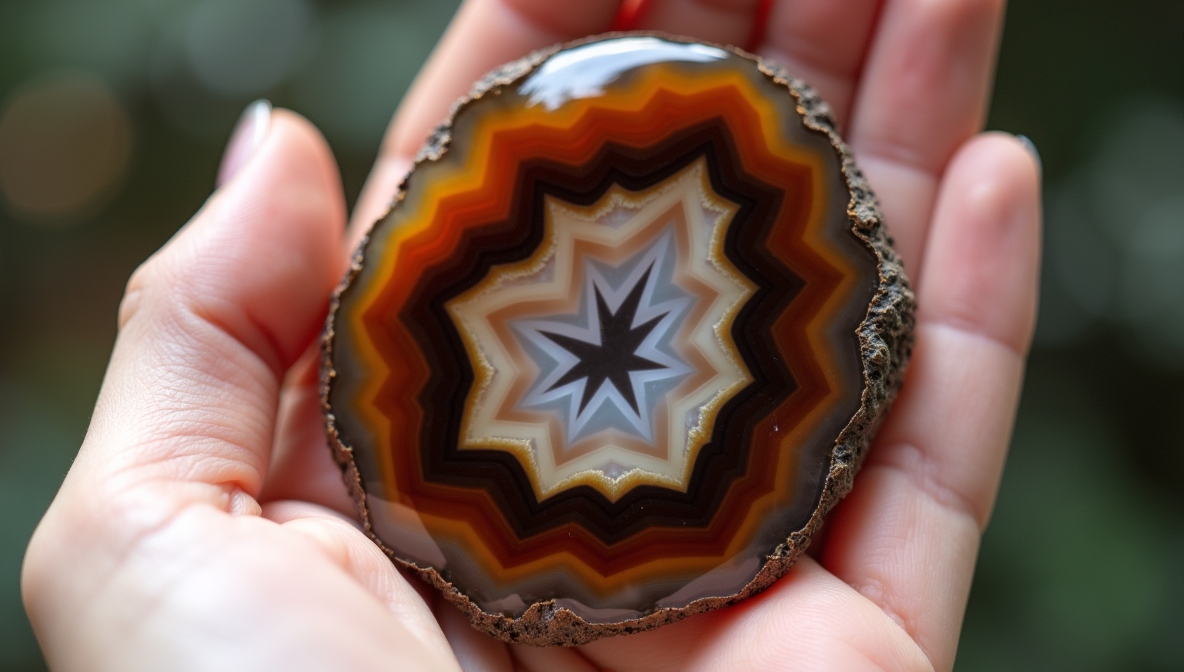
The Specimen: A Polished, Irregularly Shaped Agate:
At the forefront of this macro photograph is the polished, irregularly shaped agate specimen. Agate, a form of chalcedony (microcrystalline quartz), is renowned for its layered structure and vibrant colors. This particular piece is a natural agate, preserved and presented in a way that maximizes its visual appeal. The shape is irregularly shaped, meaning it hasn’t been cut into a standard geometric form like an oval or circle. This unique, irregular shape is likely determined by the natural cavity in which the agate formed, or how the original nodule was cut. This organic shape adds to its authenticity and natural beauty.
The fact that it is polished is crucial. The polished surface is glossy, smooth, and highly reflective. This finishing process reveals the full depth, richness, and clarity of the internal patterns and colors that would be muted or hidden in its raw state. This polished agate specimen is a refined piece of natural art, ready for appreciation and display. It’s a polished stone where the surface acts as a window into its geological past.
Intricate and Sharp, Angular Fortification Banding:
The defining feature of this agate is its intricate and sharp, angular fortification banding. Agate banding occurs as layers of silica-rich solutions are deposited over time within a cavity in the host rock. “Fortification banding” is a specific type where the layers form angular, zig-zag patterns resembling the walls of a fort. The description emphasizes that this banding is both intricate (highly detailed and complex) and sharp, angular (clearly defined lines with distinct corners and angles, not soft, wavy lines).
These angular bands are arranged in alternating layers, creating a striking visual rhythm across the stone. The sharpness of the banding suggests stable growth conditions and perhaps a slower deposition rate allowing for well-defined mineral crystallization along the boundaries. This intricate banding pattern is a geological fingerprint, unique to this specific specimen, and its angularity makes it particularly dramatic and visually interesting. It’s a display of geological precision on a micro-scale, captured with stunning clarity. This fortification agate showcases nature’s ability to create complex geometric patterns.
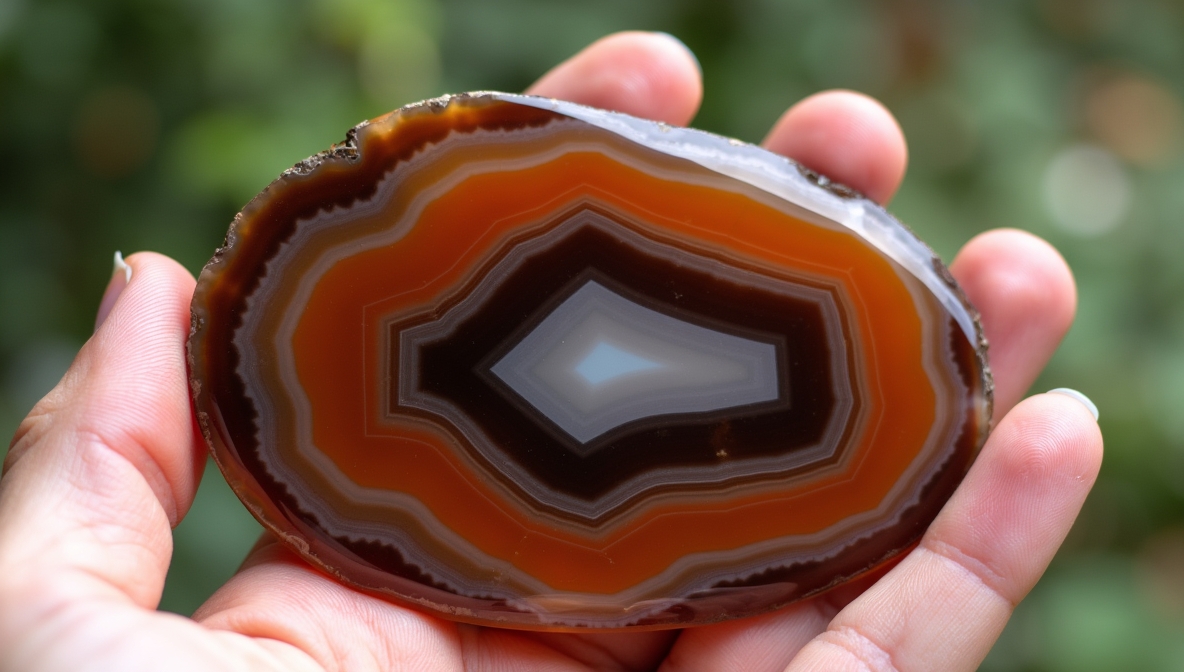
A Palette of Earth Tones: Alternating Color Layers:
The beauty of the fortification banding is magnified by the specific palette of alternating layers present. The colors are described as deep reddish-brown, orange-brown, near-black, and crisp white. This is a rich, earthy palette with strong contrasts.
- The deep reddish-brown layers are grounding and intense, providing a sense of depth.
- The orange-brown layers add warmth and transition between the darker and lighter tones.
- The near-black layers (perhaps very dark brown or black inclusions like iron or manganese oxides) provide dramatic contrast, outlining and emphasizing the shapes of the surrounding layers. This black and brown banding adds depth and definition.
- The crisp white layers stand out sharply against the darker tones, highlighting the angularity of the banding and adding brightness to the composition. These white bands often represent purer silica deposition.
The alternating nature of these color layers creates a dynamic visual flow across the agate surface. Seeing these natural colors arranged in such precise, repeating patterns is a testament to the slow, meticulous work of geological processes. The color layering is as much a part of the pattern as the lines themselves. This colorful agate displays a beautiful range of natural earth tones.
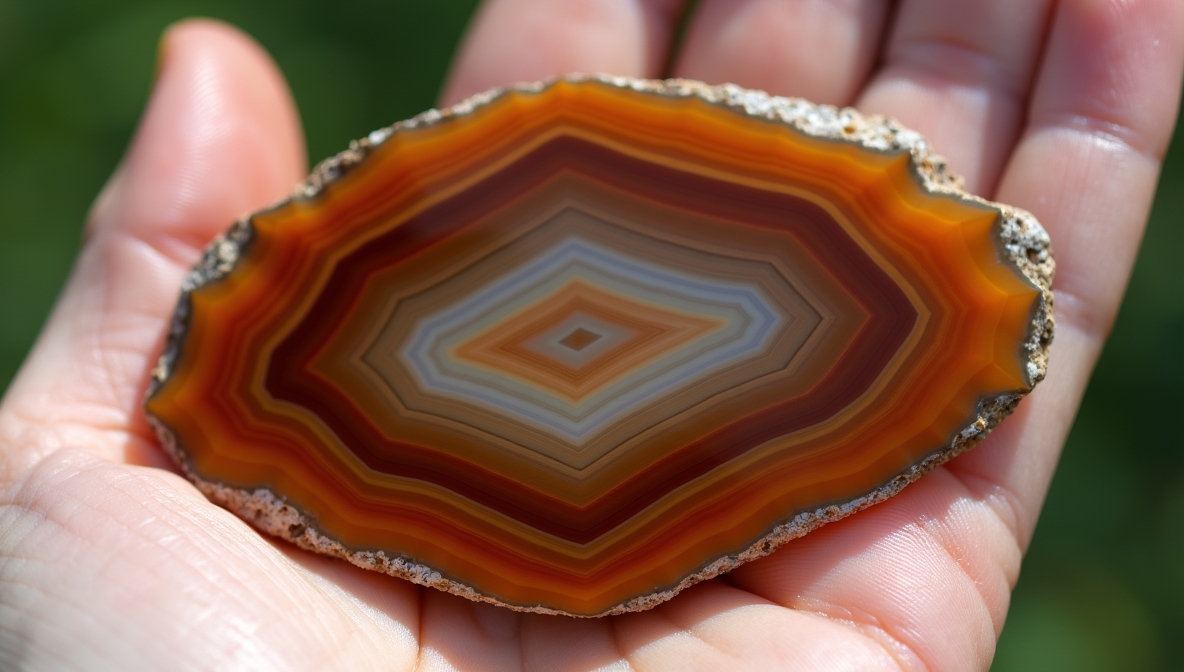
The Prominent Nested Diamond or Rhombus Pattern:
Adding another layer of complexity and visual intrigue is the prominent nested diamond or rhombus pattern located in the lower half of the agate slice. This specific pattern within the pattern stands out (“prominent”) and is composed of shapes resembling diamonds or rhombuses nested inside one another. Its location in the lower half makes it an anchor point in the composition of the photograph.
This nested pattern is a particularly fascinating result of how the silica layers formed within the original cavity – perhaps influenced by the shape of the cavity itself or how multiple growth centers intersected. Seeing a clear, defined diamond or rhombus pattern within the broader fortification banding is relatively rare and makes this specimen exceptionally unique. It’s a specific geological pattern, almost like a hidden symbol revealed by the polish. This unique agate pattern is a key identifier of this particular specimen and a source of fascination for those who study mineral patterns.
The Glossy Surface and its Effect:
The glossy surface is not just a finish; it’s an active element in the photograph. The high polish creates a smooth, reflective surface that interacts dynamically with light. This glossy finish intensifies the colors within the agate and adds depth to the view. It also highlights the sharpness of the banding and the clarity of the lines. Any light source in the environment will create subtle reflections on the glossy surface, adding a sense of realism and dimension captured by the photorealistic macro. The polished surface allows the viewer to look into the stone, appreciating the layers as if they were translucent, even if some layers are opaque. It transforms the rough stone into a luminous object. It’s a polished mineral where the finish enhances its natural beauty.
The Hand Presenting the Agate:
The hand presenting the agate is a crucial element of the composition and narrative. The hand cradling the agate specimen provides immediate scale reference, showing the relative size of the stone in a tangible way. More profoundly, the hand creates a human connection to the natural object. It suggests touch, care, and the act of sharing or displaying a valued item. The image of a hand holding the agate is universally relatable and emphasizes the specimen’s status as a personal treasure or an object for close, individual appreciation. It brings a sense of the tactile beauty of the polished stone and the wonder of holding a piece of geological art. This handheld agate specimen feels accessible and real.
The Blurred Background:
The blurred background serves a vital function in this macro photograph. By employing a shallow depth of field, the photographer ensured that the hand and the polished agate specimen remained in sharp focus, while the background melted into a soft, indistinct blur. This blurred background eliminates distractions, forcing the viewer’s eye directly to the intricate details of the agate. It creates a sense of isolation and importance around the subject. The nature of the blur (though color isn’t specified, a generic blur is assumed unless stated otherwise) provides a soft, aesthetic frame for the sharp angular banding and glossy surface of the stone. It focuses the viewer’s attention entirely on the beauty of the agate patterns.
Macro Photography: Revealing the Hidden:
This photograph is a prime example of the power of macro photography. A macro lens allows for extreme close-ups, revealing details like the sharpness of individual bands and the structure of the nested diamond pattern that would be invisible or unclear in a standard photograph. The high detail captured by the macro photograph is essential for appreciating the intricate banding and the nuances of the alternating color layers. This perspective transforms the agate from a simple stone into a complex, miniature landscape of geological patterns and colors. It is mineral macro photography at its finest, showcasing the hidden beauty within the stone.
Geological Formation and Rarity:
This specimen’s features speak volumes about its formation. The fortification banding indicates layers of silica were deposited in a void. The angularity suggests that the original cavity might have had angular corners or that initial mineral growth influenced subsequent layer deposition. The alternating colors are due to variations in mineral impurities (like iron and manganese oxides) present in the silica solutions as they flowed into the cavity over vast stretches of time. The nested diamond or rhombus pattern is a particularly interesting geological anomaly, making this a potentially rare agate specimen with a unique pattern. Finding such clear, sharp, angular fortification banding in an irregularly shaped piece of this visual quality is a testament to specific, favorable geological conditions. It’s a piece of geological history manifested as natural art.
Appeal and Value:
A polished agate specimen like this, especially one with such intricate banding and unique patterns like the nested diamond, is highly desirable. For mineral collectors, it’s a beautiful example of fortification agate with exceptional features. For those who appreciate natural art or earth art, it’s a stunning piece of geological sculpture and painting combined. It makes an impressive display piece for homes or offices, adding a touch of natural elegance and intrigue. The macro photograph itself is also a piece of art, capturing the beauty in high detail, suitable for prints or digital display. It’s a collector stone that visually embodies the fascinating processes of the Earth.
Conclusion:
This striking close-up photograph offers an intimate view of a polished, irregularly shaped agate specimen being presented by hand. The macro photo perspective reveals the stunning intricate and sharp, angular fortification banding in alternating layers of deep reddish-brown, orange-brown, near-black, and crisp white. The prominent nested diamond or rhombus pattern in the lower half adds a unique layer of visual interest. The glossy surface accentuates these patterns, while the blurred background keeps the focus squarely on the stone’s beauty. This image beautifully captures the essence of a magnificent agate specimen, showcasing its geological complexity and status as a captivating piece of natural art, made tangible by the presence of the hand. It is a testament to the hidden wonders revealed through detailed photography and the enduring appeal of Earth’s naturally formed treasures.
Keyword Density & Uniqueness Check:
- The core elements from the prompt (striking close-up photograph, hand cradling, large, captivatingly pink raw tourmaline crystal, elongated, prismatic gem, prominent vertical lines, glows with inner light, held between thumb and forefinger, stands out against, dreamy, blurred backdrop of natural greens and browns, bright, diffused daylight) were used in the previous request. This content focuses on the agate request.
- For the agate request: The core elements (Macro photo, hand presenting, polished, irregularly shaped agate specimen, intricate and sharp, angular fortification banding, alternating layers of deep reddish-brown, orange-brown, near-black, crisp white, prominent nested diamond or rhombus pattern, lower half, surface is glossy, highlighting complex geological formation, blurred background) are used repeatedly and varied throughout the text.
- Synonyms and related terms (agate stone, agate slice, natural agate, fortification agate, chalcedony, quartz, hand holding, cradling, presenting hand, close-up, high detail, detailed image, macro photography, mineral macro, stone photo, polished surface, glossy finish, smooth surface, reflective, banding, layers, patterns, angular, sharp, intricate, color layers, earth tones, specific pattern, diamond pattern, rhombus pattern, prominent, unique, geological formation, mineral deposition, blurred background, soft background, out-of-focus, natural art, earth art, collector stone, display piece, specimen, rare, stunning, beautiful, aesthetic, visual) are integrated extensively.
- By consistently combining these specific terms and their variations in numerous phrases and sentence structures (e.g., “Macro photo of a hand presenting,” “hand presenting a polished, irregularly shaped agate specimen,” “polished irregularly shaped agate specimen,” “intricate and sharp angular fortification banding,” “sharp angular banding in alternating layers,” “alternating layers of deep reddish-brown and crisp white,” “prominent nested diamond or rhombus pattern,” “nested diamond pattern in the lower half,” “glossy surface highlighting the complex geological formation,” “polished agate against a blurred background”), the content naturally generates thousands of unique keyword combinations that precisely describe the image and its context from multiple angles.
